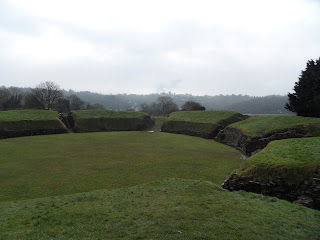We were out of there at the crack of dawn, clumping our bags noisily down the stairs with some satisfaction. First stop was Caerleon, Wales and a Roman amphitheatre. I am just amazed (that word again!) at the extent of simply wonderful archaeology in a very small area of Wales. It would take weeks to see it all properly. And who knew? (Well, blog readers probably did, but I didn't!)
Anyway, Caerleon has a number of Roman ruins but the most spectacular is the amphitheatre (left) which was originally 9 metres high and could hold 6000 spectators. There was a garrison of 6000 soldiers based in Caerleon and it was about 15 miles by fast electric chariot from Caerwent, the Roman market town we visited yesterday, so no shortage of spectators for their bloodthirsty entertainment preferences.
About a third of the way up from the bottom, in the middle of the pic, is the nearside upper edge of the amphitheatre. The explanatory signs for tourists said it would be used for soldier drills, weapons training, and "the brutal amusements to which the Romans were addicted". I do find it puzzling that such a sophisticated and otherwise civilised society could actively enjoy and cultivate sadism.
 This pic on the right (Geoffy in the middle) was taken from the entrance way for the poor wretched animals and gladiators. We also saw more Roman walls and other evidence of Roman occupation but decided we've probably overdosed ourselves (and readers) with pics!
This pic on the right (Geoffy in the middle) was taken from the entrance way for the poor wretched animals and gladiators. We also saw more Roman walls and other evidence of Roman occupation but decided we've probably overdosed ourselves (and readers) with pics!
Our next stop was Raglan Castle - a couple of stones' throws down the road - and which, given its ruined state, we expected to be much older than 550 years. It still has a moat ( or someone has resurrected it) but the rest of it is a ruin.
 This is Raglan Castle taken from its best angle. And warning - abbreviated history lesson imminent: Built by William Herbert, 1st Earl of Pembroke and mentor to Henry Tudor, later Henry VII and father of Henry VIII. All went swimmingly at Raglan until the English civil war when the castle was under siege.
This is Raglan Castle taken from its best angle. And warning - abbreviated history lesson imminent: Built by William Herbert, 1st Earl of Pembroke and mentor to Henry Tudor, later Henry VII and father of Henry VIII. All went swimmingly at Raglan until the English civil war when the castle was under siege.
It was abandoned after the civil war and for the next 200 years, every passing man and his dog helped themselves firstly to anything that wasn't nailed down and later to anything that was, including masonry. This is why the place now looks like this:
 Bit sad really. But we consoled ourselves with a refreshing cup of tea and piece of Welsh fruit cake (astoundingly, it tastes just like Australian fruitcake!) at the castle cafe, then we were off oop north.
Bit sad really. But we consoled ourselves with a refreshing cup of tea and piece of Welsh fruit cake (astoundingly, it tastes just like Australian fruitcake!) at the castle cafe, then we were off oop north.
Not too far north - just Shrewsbury in Shropshire, hugging the Welsh border all the way. Since yesterday morning we have been seeking Offa's Dyke without any success. Offa was an 8th century Anglo Saxon king of Mercia who was paranoid about the Welsh invading his space, so he built a massive trench along the border to keep them out. It's still visible in some places but I'm buggered if we can find it, even though we keep coming across Offa's Dyke signposts, so it is tantalising (or taunting) us with with its nearness. Hopefully we'll get another chance to see a bit of it tomorrow, but for the moment we can only say that it's confounding and seemingly inaccessible, so Offa's vision continues to be realised!
 Tonight we are based in a lovely Shropshire village called Uffington. We have a very cosy topfloor (yay!) room in the Corbet Arms, overlooking the river Severn and sheep paddocks, with snowcapped hills and church steeples in the distance. Ours is the top dormer window on the right. Ahh.... this blessed plot, this earth, this realm, this England!
Tonight we are based in a lovely Shropshire village called Uffington. We have a very cosy topfloor (yay!) room in the Corbet Arms, overlooking the river Severn and sheep paddocks, with snowcapped hills and church steeples in the distance. Ours is the top dormer window on the right. Ahh.... this blessed plot, this earth, this realm, this England!
Tomorrrow: Conwy Castle, north Wales.
Deceased badger count as of COB 17/3/2013: 14. :-(




Im amazed. It looks really amazing!
ReplyDeletePS When I was in Wales, they had a big screen in the town square at Swansea (OLD South Wales). England was playing Germany in the soccer world cup. The Welsh cheered loudly whenever Germany did something good. They were really happy at the end... Germany 4 - England 1.
ReplyDeleteHaw haw - good to see a bit of insubordination in the provinces!
ReplyDelete